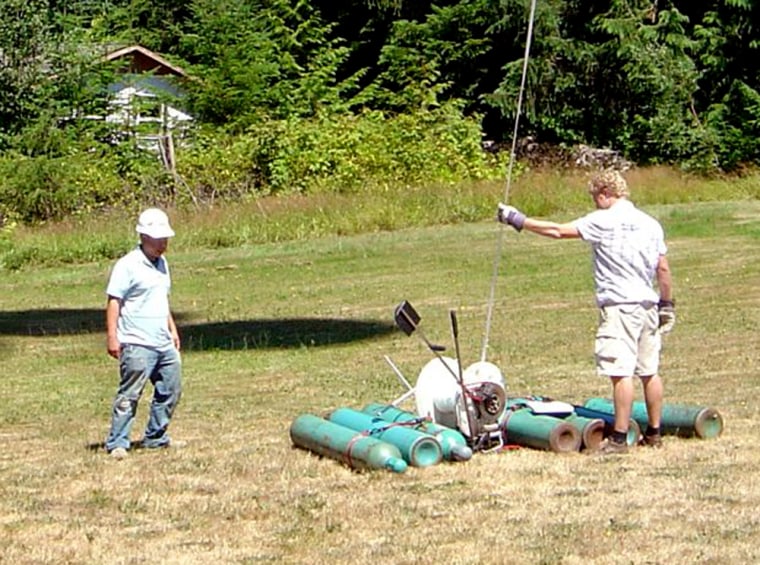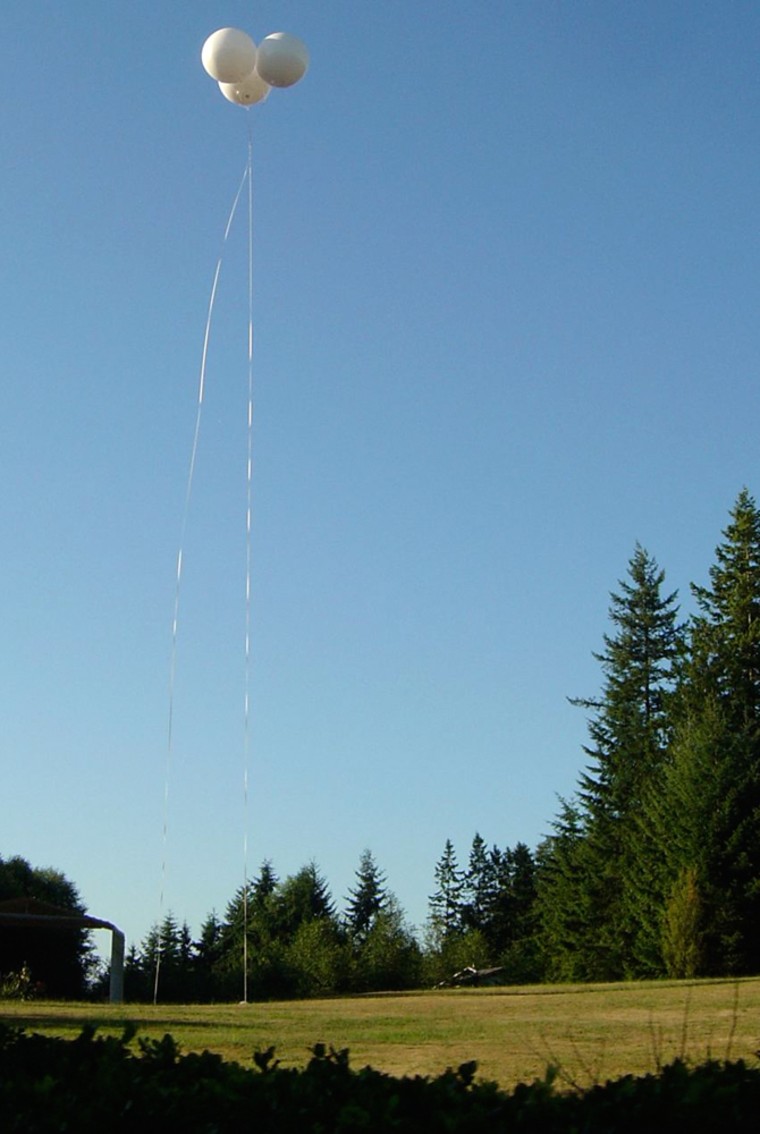A company that someday hopes to build the first space elevator says it is testing a system that could take it to a lower-altitude goal along the way: balloon-based wireless data services.
The LiftPort Group, based in Bremerton, Wash., is in the midst of a two-month test to see if a balloon-based platform, moored to the ground, can serve as a reliable relay for Internet traffic in remote areas — serving "the guys that everybody else forgot," said the company's founder and president, Michael Laine.
Laine told MSNBC.com that the Federal Aviation Administration granted a waiver for the test in a rural area near Poulsbo on western Washington's Kitsap Peninsula. The test began last week with the three-balloon cluster rising to the 150-foot (45-meter) level, and now the platform is being outfitted with lights so that it can ascend to a height of 300 to 500 feet (90 to 150 meters), he said. Air traffic controllers in Seattle confirmed that they were aware of the test, which is to conclude by Sept. 24.
For the past year, LiftPort has been using helium-filled balloons as a method for raising fabric ribbons into the sky, to facilitate tests of the company's robotic "climbers."
Laine's dream is to develop a tether-and-climber system that could one day loft payloads and people thousands of miles into orbit. This space elevator concept has been the subject of science-fiction speculation for decades, but interest in actually turning it into reality has been on the upswing only in the past few years.
NASA is offering cash prizes to encourage the development of the technologies required for space elevators — such as beamed power systems and super-strong, lightweight carbon nanotube materials — but most experts say it will take a decade or more to build an actual space elevator, if it can be done at all.
Telecom visions
In the shorter term, LiftPort has been casting around for ways to apply the technological building blocks of the space elevator scheme to more grounded pursuits. Laine said his company already has a client for the technology: Lightspeed Broadband, a wireless Internet access provider based in Port Angeles, Wash.
"These guys are actually going to pay for this system now, under development," Laine said.
Lightspeed's president, Jamie Aggen, told MSNBC.com that his fledgling company hoped to use balloon-lofted signal relays to weave meshes of wireless Internet and voice-over-Internet services — initially across the Kitsap Peninsula, and eventually in other areas as well. Aggen said the system also could be used to facilitate "quick, early response to disaster areas," with last year's Hurricane Katrina devastation serving as a prime example.
Aggen said that Lightspeed currently has fewer than 200 subscribers in western Washington for its antenna-based wireless broadband services. But he shared Laine's hope that the technology currently being tested would set the stage for the company's expansion.
"He has a vision of going to space, and now we have a vision of deploying telecom," Aggen said. "We think it's totally achievable."
If the technology pans out and the FAA gives its assent for continuing operations, Lightspeed could offer $20-a-month broadband to customers who currently can get only dial-up service at a higher cost, Laine said. Participating in such a venture would give LiftPort its first significant revenue stream.
"It's our first cash cow," Laine said. "That sounds kind of crass, but up until now, we've been funded by private investors. ... It's lucrative enough that it's going to be a big help."
Not the first
LiftPort is by no means the first company to come up with the concept of balloon-lofted communication platforms: Over the past decade, a succession of ventures have worked on the concept under a variety of names — such as SkyTowers, Sky Stations, Sky Dragons and Stratellites. Gadget-laden blimps already have been used by the U.S. military in Iraq as communication relays.

LiftPort's concept is relatively low-tech and low-altitude, essentially relying on clusters of weather balloons held in place by a network of tethers. For this summer's test, the balloons are floating above a privately owned apple orchard, Laine said. Once the balloons rise to the 500-foot level, "we're expecting the FAA to get calls about UFOs," he said.
"If it works till the end of September ... we're going to ask for an extension" from the FAA, he said.
Eventually, Laine hopes to conduct a yearlong test to see how well the balloons stand up to the weather and day-to-day wear. Historically, high winds have been the downfall for balloon platforms — and the concept may also pose challenges for air traffic clearances.
"This requires the FAA to completely rethink how they think of communication 'towers,'" Laine said. "This 'tower' is longer and higher, and it's floppy."
What's more, the balloons could conceivably fall prey to birds, gun-wielding pranksters or slow helium leaks.
‘Commercially useful’
Even then, the balloons could be quickly replaced — demonstrating the system's usefulness as an emergency communication method, if nothing else, Laine said.
"We already have a system that's commercially useful, even if it fails this afternoon," he told MSNBC.com.
Laine said the system had other potential applications as well — for weather monitoring, surveillance and security monitoring, and for aerial surveys related to "precision farming."
At the same time that LiftPort is developing the moored-balloon system, it's also setting up a carbon nanotube manufacturing plant in New Jersey, aided by $100,000 in public seed money. Ultra-strong nanotube materials happen to be another piece of the space elevator puzzle.
Laine had hoped that the nanotube venture would be LiftPort's first big revenue-generator, but he said perfecting the manufacturing process has turned out to be more difficult than expected. "We're at least seven months behind schedule," he said.
Building public interest
Laine and LiftPort have also created products to build public interest in the space elevator concept — including an anthology titled "Liftport: Opening Space to Everyone," a series of retro posters with space elevator themes, and an offering of novelty "Lift Tickets" to geosynchronous orbit ("not valid for actual transport").
Other ventures are chasing the space elevator dream as well — including the California-based Spaceward Foundation, organizer of the NASA-backed Space Elevator Games, and Seattle-based X-Tech Projects.
For now, LiftPort's Web site continues to count down to its projected first lift: April 12, 2018. But Laine said that countdown may have to be changed.
"As we are getting deeper and deeper into this project, and understanding the complexity, we're thinking that timetable is going to be pushed back," he said. "Which is kind of what we expected."
Is LiftPort's timetable too optimistic? What about its business plan? Share your opinion with Cosmic Log.
